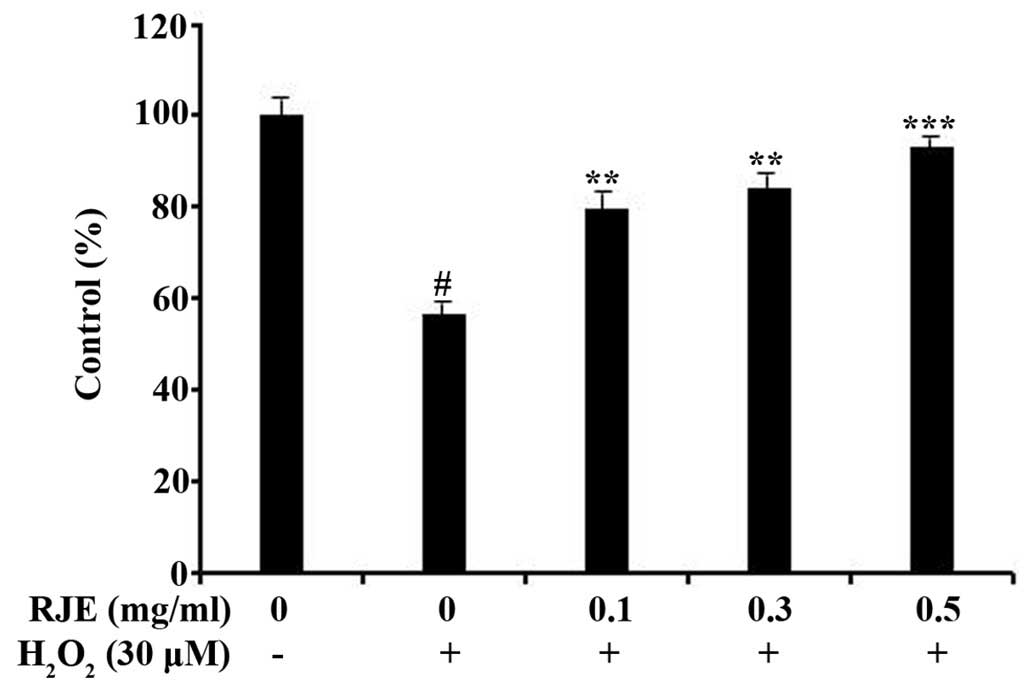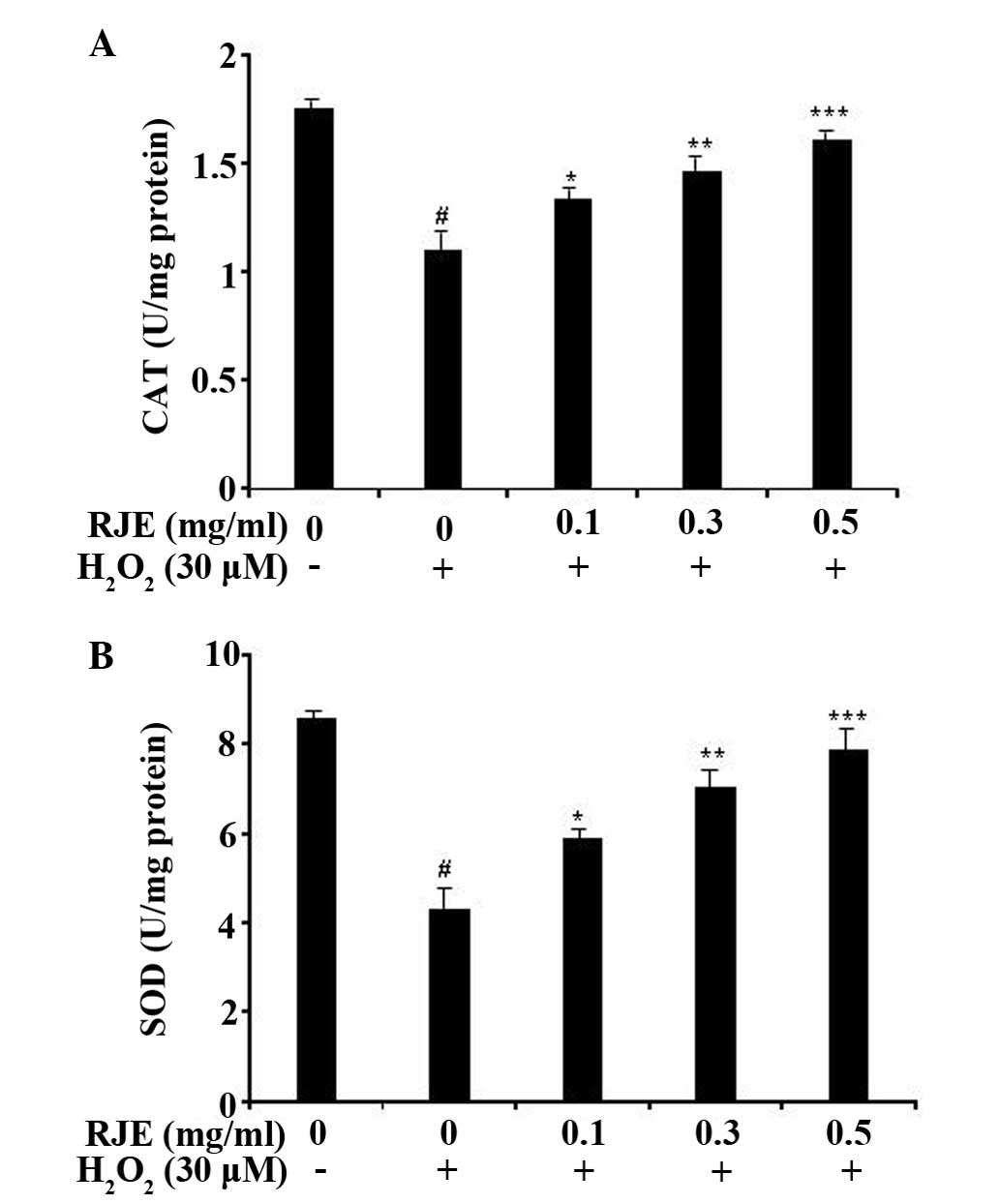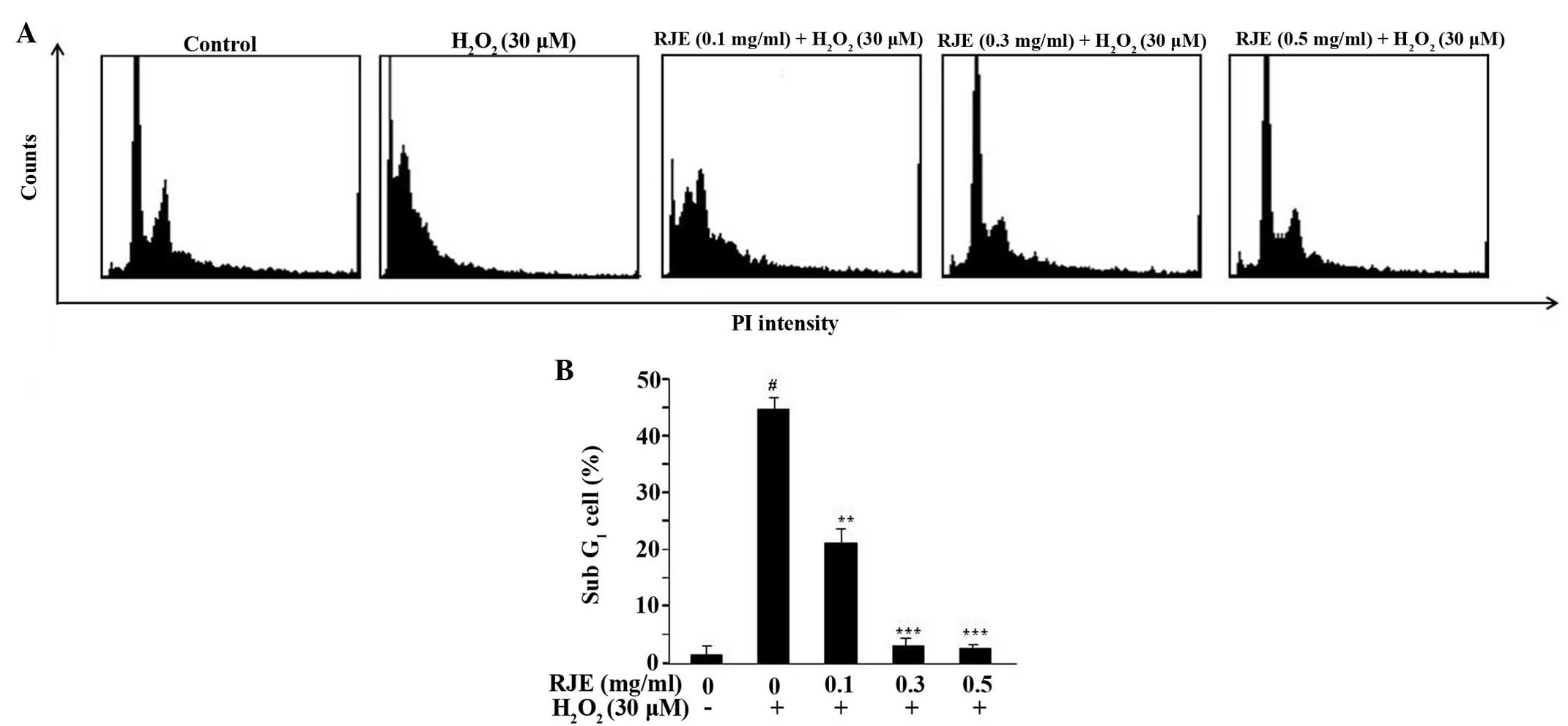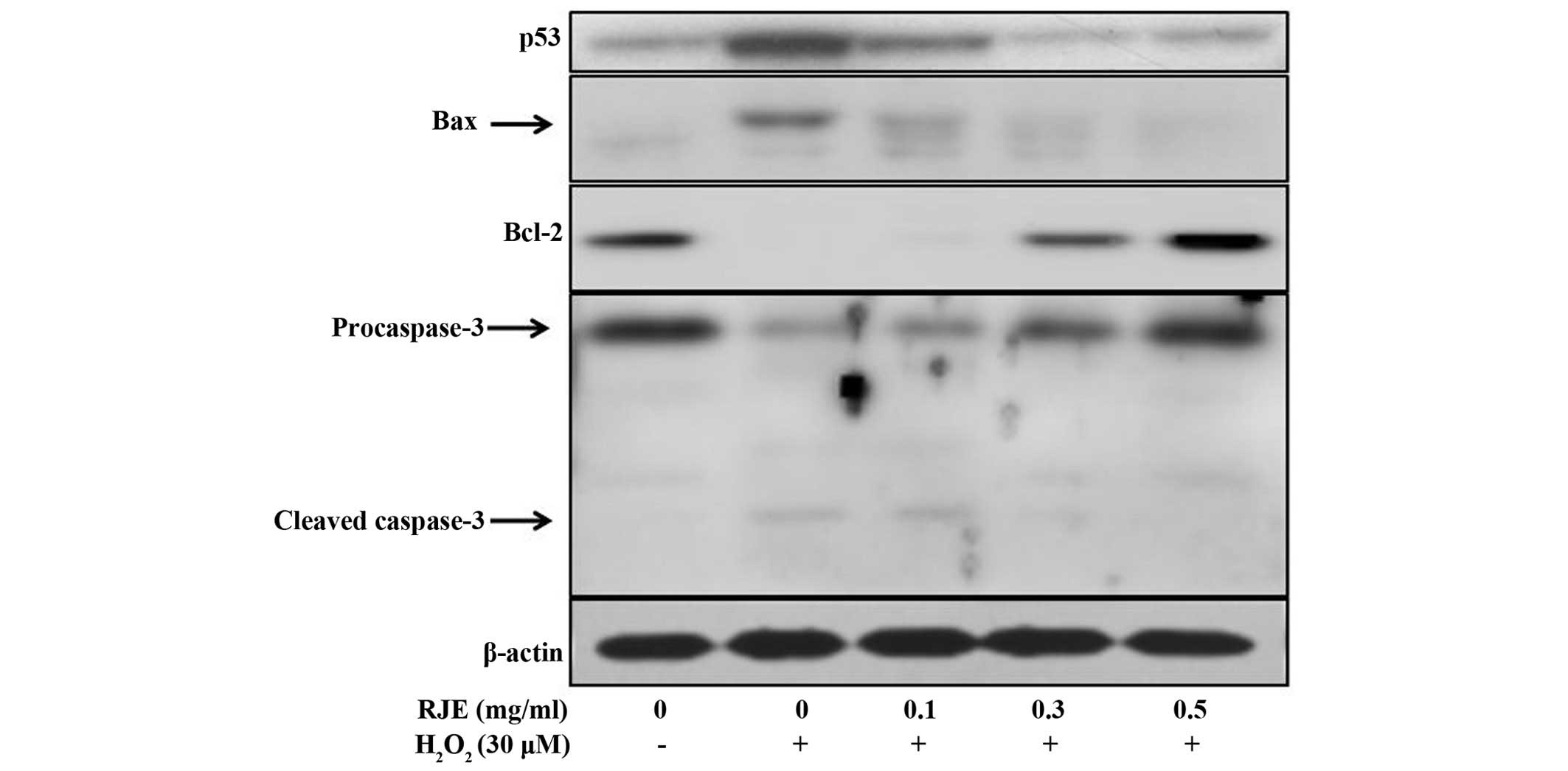|
1
|
Saladin KS: Anatomy & Physiology. The
Unity of Form and Function. 6th ed. The McGraw-Hill Companies; USA:
pp. 887–925. 2011
|
|
2
|
Muriel P: Role of free radicals in liver
diseases. Hepatol Int. 3:526–36. 2009. View Article : Google Scholar : PubMed/NCBI
|
|
3
|
Nordberg J and Arnér ES: Reactive oxygen
species, antioxidants, and the mammalian thioredoxin system. Free
Radic Biol Med. 31:1287–1312. 2001. View Article : Google Scholar : PubMed/NCBI
|
|
4
|
Medina J and Moreno-Otero R:
Pathophysiological basis for antioxidant therapy in chronic liver
disease. Drugs. 65:2445–2461. 2005. View Article : Google Scholar : PubMed/NCBI
|
|
5
|
Cerella C, Coppola S, Maresca V, De Nicola
M, Radogna F and Ghibelli L: Multiple mechanisms for hydrogen
peroxide-induced apoptosis. Ann N Y Acad Sci. 1171:559–563. 2009.
View Article : Google Scholar : PubMed/NCBI
|
|
6
|
Clément MV, Ponton A and Pervaiz S:
Apoptosis induced by hydrogen peroxide is mediated by decreased
superoxide anion concentration and reduction of intracellular
milieu. FEBS Lett. 440:13–18. 1998. View Article : Google Scholar : PubMed/NCBI
|
|
7
|
Kim MH, Chung J, Yang JW, Chung SM, Kwag
NH and Yoo JS: Hydrogen peroxide-induced cell death in a human
retinal pigment epithelial cell line, ARPE-19. Korean J Ophthalmol.
17:19–28. 2003. View Article : Google Scholar : PubMed/NCBI
|
|
8
|
Sharma A, Chakraborti KK and Handa SS:
Anti-hepatotoxic activity of some Indian herbal formulations as
compared to silymarin. Fitoterapia. 62:229–235. 1991.
|
|
9
|
Britton RS and Bacon BR: Role of free
radicals in liver diseases and hepatic fibrosis.
Hepatogastroenterology. 41:343–348. 1994.PubMed/NCBI
|
|
10
|
Cha BC, Lee SB, Rhim TJ and Lee KH:
Constituents of anti-oxidative activity and free radical scavenging
effect from Galla Rhois (Rhus javanica Linne). Korean J Pharmacogn.
31:185–189. 2000.
|
|
11
|
Lee IS, Oh SR, Ahn KS and Lee HK:
Semialactone, isofou-quierone peroxide and fouquierone, three new
dammarane triterpenes from Rhus javanica. Chem Pharm Bull (Tokyo).
49:1024–1026. 2001. View Article : Google Scholar
|
|
12
|
Ahn DK: Illustrated Book of Korean
Medicinal Herbs. Kyo-Hak Publisher; Seoul, South Korea: 1998
|
|
13
|
You YO, Choi NY, Kang SY and Kim KJ:
Antibacterial Activity of Rhus javanica against
Methicillin-Resistant Staphylococcus aureus. Evid Based Complement
Alternat Med. 2013:5492072013. View Article : Google Scholar : PubMed/NCBI
|
|
14
|
Djakpo O and Yao W: Rhus chinensis and
Galla chinensis - folklore to modern evidence: Review. Phytother
Res. 24:1739–1747. 2010. View
Article : Google Scholar : PubMed/NCBI
|
|
15
|
Szeto YT, Chu WK and Benzie IFF:
Antioxidants in fruits and vegetables: A study of cellular
availability and direct effects on human DNA. Biosci Biotechnol
Biochem. 70:2551–2555. 2006. View Article : Google Scholar : PubMed/NCBI
|
|
16
|
Re R, Pellegrini N, Proteggente A, Pannala
A, Yang M and Rice-Evans C: Antioxidant activity applying an
improved ABTS radical cation decolorization assay. Free Radic Biol
Med. 26:1231–1237. 1999. View Article : Google Scholar : PubMed/NCBI
|
|
17
|
Wolfe K, Wu X and Liu RH: Antioxidant
activity of apple peels. J Agric Food Chem. 51:609–614. 2003.
View Article : Google Scholar : PubMed/NCBI
|
|
18
|
Kim DO, Jeong SW and Lee CY: Antioxidant
capacity of phenolic phytochemicals from various cultivars of
plums. Food Chem. 81:321–326. 2003. View Article : Google Scholar
|
|
19
|
Muller L, Gnoyke S, Popken AM and Bohm V:
Antioxidant capacity and related parameters of different fruit
formulations. LWT-Food Sci Technol. 43:992–999. 2010. View Article : Google Scholar
|
|
20
|
Othman A, Ismail A, Ghani AN and Adenan I:
Antioxidant capacity and phenolic content of cocoa beans. Food
Chem. 100:1523–1530. 2007. View Article : Google Scholar
|
|
21
|
Zhang R, Kang KA, Piao MJ, Kim KC, Kim AD,
Chae S, Park JS, Youn UJ and Hyun JW: Cytoprotective effect of the
fruits of Lycium chinense Miller against oxidative stress-induced
hepatotoxicity. J Ethnopharmacol. 130:299–306. 2010. View Article : Google Scholar : PubMed/NCBI
|
|
22
|
Sindhu RK, Koo JR, Roberts CK and Vaziri
ND: Dysregulation of hepatic superoxide dismutase, catalase and
glutathione peroxide in diabetes: Response to insulin and
antioxidant therapies. Clin Exp Hypertens. 26:43–53. 2004.
View Article : Google Scholar : PubMed/NCBI
|
|
23
|
De Bleser PJ, Xu G, Rombouts K, Rogiers V
and Geerts A: Glutathione levels discriminate between oxidative
stress and transforming growth factor-beta signaling in activated
rat hepatic stellate cells. J Biol Chem. 274:33881–33887. 1999.
View Article : Google Scholar : PubMed/NCBI
|
|
24
|
Gopinath P, Gogoi SK, Sanpui P, Paul A,
Chattopadhyay A and Ghosh SS: Signaling gene cascade in silver
nanoparticle induced apoptosis. Colloids Surf B Biointerfaces.
77:240–245. 2010. View Article : Google Scholar : PubMed/NCBI
|
|
25
|
Sherr CJ: Principles of tumor suppression.
Cell. 116:235–246. 2004. View Article : Google Scholar : PubMed/NCBI
|
|
26
|
Chiu CL, Lee TH, Shao YY and Kuo YH: Three
new triterpenes from the roots of Rhus javanica L. var.
roxburghuna. J Asian Nat Prod Res. 10:684–688. 2008. View Article : Google Scholar
|
|
27
|
Gao C and Wang AY: Significance of
increased apoptosis and Bax expression in human small intestinal
adenocarcinoma. J Histochem Cytochem. 57:1139–1148. 2009.
View Article : Google Scholar : PubMed/NCBI
|
|
28
|
Timmer JC and Salvesen GS: Caspase
substrates. Cell Death Differ. 14:66–72. 2007. View Article : Google Scholar
|
|
29
|
Youle RJ and Strasser A: The Bcl-2 protein
family: Opposing activities that mediate cell death. Nat Rev Mol
Cell Biol. 9:47–59. 2008. View Article : Google Scholar
|
|
30
|
Ahmad J, Ahamed M, Akhtar MJ, Alrokayan
SA, Siddiqui MA, Musarrat J and Al-Khedhairy AA: Apoptosis
induction by silica nanoparticles mediated through reactive oxygen
species in human liver cell line HepG2. Toxicol Appl Pharmacol.
259:160–168. 2012. View Article : Google Scholar : PubMed/NCBI
|
|
31
|
Chung SC, Hwang BY, Oh GJ, Kang SJ, Kim
MJ, Choi WH, Lee KS and Ro JS: Chemical components from the stem
bark of Rhus javanica. L Kor J Pharmacogn. 30:295–300. 1999.
|
|
32
|
Aruoma O, Murcia A, Butler J and Halliwell
B: Evaluation of the antioxidant and prooxidant actions of gallic
acid and its derivatives. J Agric Food Chem. 41:1880–1885. 1993.
View Article : Google Scholar
|
|
33
|
Devbhuti P, Roy S, Sarkar RG and Devbhut
D: An in vitro study on effect of lactic acid and ascorbic acid on
etoposide-induced lipid peroxidation. J Pharma Sci Technol.
2:91–95. 2013.
|














